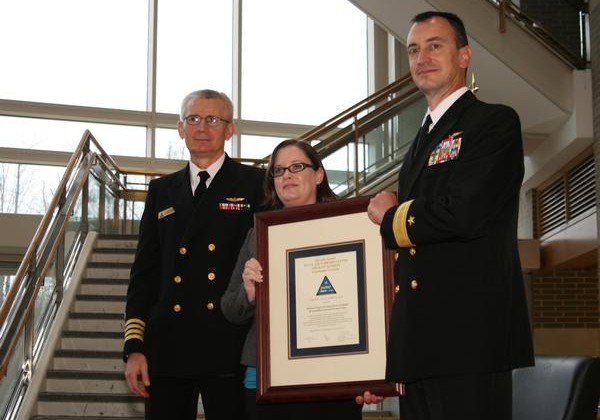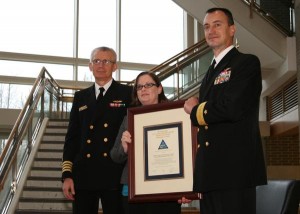O2 Deprivation Team Honored

 The team responsible for developing an innovative training system that teaches oxygen deprivation recognition was recently honored with a commander’s award.
The team responsible for developing an innovative training system that teaches oxygen deprivation recognition was recently honored with a commander’s award.
The Reduced Oxygen Breathing Device and Spatial Disorientation (ROBD-SD) integrated product team received a Naval Air Warfare Center, Aircraft Division Commander’s team award during a ceremony at the Rear Adm. William A. Moffett building, Dec. 7.
The team comprising Naval Aviation Training Systems Program Office (PMA-205); Naval Air Warfare Center, Training Systems Division (NAWCTSD); and industry partners, received the honor for the development of a first-of-its-kind training system, which is a potential milestone contribution to naval aviation safety.
The partial task trainer was developed under the Small Business Innovation Research program at low-cost.
Pilots learn to recognize the visual symptoms of spatial disorientation and obtain situational awareness as aircrews perform standard flight crew duties. It can also be used with the current ROBD system, manufactured by Environics, for hypoxia training.
“It is imperative that we continue to seek out more cost effective solutions to better equip the men and women who serve,” said Capt. John Feeney, PMA-205 program manager. “For the first time, hypoxia and spatial disorientation training can be offered on one device and with greater quality to enable warfighters to complete aviation missions under extreme conditions.”
Hypoxia, or oxygen deprivation, causes loss of mental and physical abilities, while also creating a sense of euphoria. The military trains pilots to recognize the symptoms of hypoxia using an altitude chamber, or the Environics ROBD system. These systems do not offer the operational realism the pilots need.
Beth Atkinson, ROBD-SD IPT lead and NAWCTSD research psychologist, said the device leverages a cockpit that provides realistic, moderate-fidelity controls modeled after a standard F/A-18 cockpit to provide a more realistic, robust feel.
“Our diverse team demonstrated what can be accomplished when multiple organizations, competencies and areas of expertise are brought together and work cooperatively,” said Atkinson, who accepted the award on behalf of the ROBD-SD team.
Hypoxia, spatial disorientation and situational-awareness training is one of the top strategic priorities of the Naval Aviation Survival Training Program and the Naval Survival Training Institute.
Currently, the ROBD-SD has two devices available for the F/A-18 Super Hornet and the T-45 Goshawk at the Manned Flight Simulator at Naval Air Station (NAS) Patuxent River, Md. One device will be transferred to Naval Air Station Pensacola, Fla., in early 2012 for development of specific training scenarios and curriculum. The V-22 Osprey and EA-6B Prowler devices, along with other airframe versions, are planned this year.
Source: AIR-1.0 Public Affairs






















